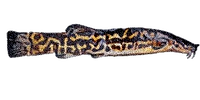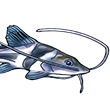Am I doing this correctly?
Am I doing this correctly?
Hi,
For the past 6 years or so, I have had a fish tank and have been mostly just keeping Tetras and maybe a pair of panda cories to help keep the tank a little bit cleaner. Recently (3 weeks ago) I was able to basically start from scratch (as far as the fish were concerned). I purchased 3 Bloodfin Tetras and a Common Pleco which I gave to a LFS after a local pet shop had sold it to me and had not told me it was going to be way too large for my 15 gallon tank (approximately 2ft x 1ft x 1ft). About a week after that I added 3 more bloodfin's to make a nice school of them. After giving away my common I became obsessed with Pleco's and was equally obsessed with finding a clown pleco (Panaque Maccus) or two for my tank. Yesterday I found them at another LFS.
---- Sorry for the long introduction -----
Today I added my 8" x 4" x 4" piece of malaysian driftwood to the tank after boiling it for a 1/2 hour. I know the Panaque Maccus is not a very outgoing fish and I probably would see them for a while but I was wondering how I could make sure that they are eating correctly and being healthy? One of them, is in an extremely dark cave I made for him in the front the the aquarium, and the other has found a tunnel underneath the driftwood (took me over 20 minutes to search my 15gallon tank to find him with my LED flashlight, lol). I dropped half of an algae waffer down in front of the plec in the rock cave but it appears the only ones that are eating it are the tetras... I hope that the other one has taken the time to realize he's inside a major food source and starts to eat his tunnel. Is that anything else I can do except wait for them to come out to make sure they are acting normally?
Any help would be greatly appreciated, sorry for the rambling.
-Greg Kirby
For the past 6 years or so, I have had a fish tank and have been mostly just keeping Tetras and maybe a pair of panda cories to help keep the tank a little bit cleaner. Recently (3 weeks ago) I was able to basically start from scratch (as far as the fish were concerned). I purchased 3 Bloodfin Tetras and a Common Pleco which I gave to a LFS after a local pet shop had sold it to me and had not told me it was going to be way too large for my 15 gallon tank (approximately 2ft x 1ft x 1ft). About a week after that I added 3 more bloodfin's to make a nice school of them. After giving away my common I became obsessed with Pleco's and was equally obsessed with finding a clown pleco (Panaque Maccus) or two for my tank. Yesterday I found them at another LFS.
---- Sorry for the long introduction -----
Today I added my 8" x 4" x 4" piece of malaysian driftwood to the tank after boiling it for a 1/2 hour. I know the Panaque Maccus is not a very outgoing fish and I probably would see them for a while but I was wondering how I could make sure that they are eating correctly and being healthy? One of them, is in an extremely dark cave I made for him in the front the the aquarium, and the other has found a tunnel underneath the driftwood (took me over 20 minutes to search my 15gallon tank to find him with my LED flashlight, lol). I dropped half of an algae waffer down in front of the plec in the rock cave but it appears the only ones that are eating it are the tetras... I hope that the other one has taken the time to realize he's inside a major food source and starts to eat his tunnel. Is that anything else I can do except wait for them to come out to make sure they are acting normally?
Any help would be greatly appreciated, sorry for the rambling.
-Greg Kirby
-
chris 1
- Posts: 52
- Joined: 02 Nov 2006, 04:03
- I've donated: $50.00!
- My cats species list: 13 (i:0, k:0)
- Spotted: 1
- Location 1: London. England
clown
hi gakirby,
i have had my clown for over a year now and he still does not come into the open. the only time i occasionally see him is when he come out to eat on a cucumber. even then he is very skitish. he also produces alot of waste for a small pleco, so watch that water.
jacked
i have had my clown for over a year now and he still does not come into the open. the only time i occasionally see him is when he come out to eat on a cucumber. even then he is very skitish. he also produces alot of waste for a small pleco, so watch that water.
jacked
Thanks jacked for your input. I just got home and noticed that one of the Bloodfin Tetras (about an inch and a quater long) was dead in the back of the tank near where the plecos were. When I took him out it appears that he had a clear "spike" going through his body and I was wondering if this was possibly from the clown plecos when he might of tried to enter the cave with them and startled them?
-Greg Kirby
-Greg Kirby
I am starting to get worried about my plecos. As it turns out one of them is a LDA68 (he is the more outgoing of the pair) and the other one is a Panaque Maccus. Both have been hiding in caves today, however I found were the LDA68 is, but so far no sightings of the P. Maccus. The Maccus previously disregarded a Hikari Algae Wafer which I was surprised at. I was wondering if anyone has had luck feeding either of these species broccoli and how they have responded to this new food.
-Greg Kirby
-Greg Kirby
-
TP
- Posts: 111
- Joined: 06 Feb 2006, 20:11
- I've donated: $25.00!
- My cats species list: 25 (i:0, k:0)
- My aquaria list: 7 (i:0)
- Location 1: Southport, UK
- Location 2: Southport, Merseyside, UK
Hi Greg
I wouldn't be too worried, I have four of these and hardly ever see them, I might catch sight of a tail sticking out of a crevice in the wood or see one dart across from one lump to another but I very rarely see them feed and its only on a very rare occasion I actually can catch sight of bits of all four of them at once for me to know they are stil there. If on the rare occasion one is out in the open and there is any movement outside the tank at all, it is very quickly gone. I've had them for a year an a half now and they take care of themselves very well. I've never fed broccoli but they seem to like courgette (zucchini)and Tabimin
I wouldn't be too worried, I have four of these and hardly ever see them, I might catch sight of a tail sticking out of a crevice in the wood or see one dart across from one lump to another but I very rarely see them feed and its only on a very rare occasion I actually can catch sight of bits of all four of them at once for me to know they are stil there. If on the rare occasion one is out in the open and there is any movement outside the tank at all, it is very quickly gone. I've had them for a year an a half now and they take care of themselves very well. I've never fed broccoli but they seem to like courgette (zucchini)and Tabimin
Thank you for sharing your experience with me. As it happens I am going out right now and I will make sure to get a zucchini and put it in the tank overnight.TP wrote:Hi Greg
I wouldn't be too worried, I have four of these and hardly ever see them, I might catch sight of a tail sticking out of a crevice in the wood or see one dart across from one lump to another but I very rarely see them feed and its only on a very rare occasion I actually can catch sight of bits of all four of them at once for me to know they are stil there. If on the rare occasion one is out in the open and there is any movement outside the tank at all, it is very quickly gone. I've had them for a year an a half now and they take care of themselves very well. I've never fed broccoli but they seem to like courgette (zucchini)and Tabimin
-Greg Kirby
gakirby,
mine has only grown a little over an inch, if that, this year. his growth rate seems to be quite slow. i added a blue phantom about 8 months ago and he has grown alot more in theat time then the clown did. i used to go weeks without seeing him(except for when i cleaned the tank). he does seem to come out more since i got the blue phantom. i dont know if it had anything to do with that or not.
jacked
mine has only grown a little over an inch, if that, this year. his growth rate seems to be quite slow. i added a blue phantom about 8 months ago and he has grown alot more in theat time then the clown did. i used to go weeks without seeing him(except for when i cleaned the tank). he does seem to come out more since i got the blue phantom. i dont know if it had anything to do with that or not.
jacked
It's great to keep learning about the experiences of other Clown Pleco owners so that I can know what to expect. Mine definitely have two very different personalities. One of them is still hidden while the other has decided to hang off of the suction cup that attaches the heater to the back wall of the tank (he's been there for hours and wont even leave if he sees me). I am planning on sinking some zucchini in the tank tonight to see if I have any takers.jacked wrote:gakirby,
mine has only grown a little over an inch, if that, this year. his growth rate seems to be quite slow. i added a blue phantom about 8 months ago and he has grown alot more in theat time then the clown did. i used to go weeks without seeing him(except for when i cleaned the tank). he does seem to come out more since i got the blue phantom. i dont know if it had anything to do with that or not.
jacked
Thanks again,
Greg Kirby
- apistomaster
- Posts: 4735
- Joined: 10 Jun 2006, 14:26
- I've donated: $90.00!
- My articles: 1
- My cats species list: 12 (i:0, k:0)
- My Wishlist: 1
- Location 1: Clarkston, WA, USA
- Location 2: Clarkston, WA, USA
- Interests: Aquaculture and flyfishing
Panaque maccus are among the most reclusive of plecos and are nearly completely noctural. That will change little. They are slow growing but then again they don't get very big anyway. Not the greatest algae eaters, they will live off the driftwood and night time feedings. I quit keeping them because they just don't come out or do enough to hold my interest. They also eat a considerable amount of higher protein foods than the "common plecostomus" so be sure to offer bottom feeder tabs occassionally at lights out. You may wish to consider returning them and getting Bushynoses instead as they do come out and are good algae eaters and stay fairly small.
Avid Trout fly fisherman. ·´¯`·...¸><)))º>
Am I doing this right? (Now with Images)
I understood that they are very reclusive fish when I researched and purchased them, however that is fine,apistomaster wrote:Panaque maccus are among the most reclusive of pl*cos and are nearly completely noctural. That will change little. They are slow growing but then again they don't get very big anyway. Not the greatest algae eaters, they will live off the driftwood and night time feedings. I quit keeping them because they just don't come out or do enough to hold my interest. They also eat a considerable amount of higher protein foods than the "common plecostomus" so be sure to offer bottom feeder tabs occassionally at lights out. You may wish to consider returning them and getting Bushynoses instead as they do come out and are good algae eaters and stay fairly small.
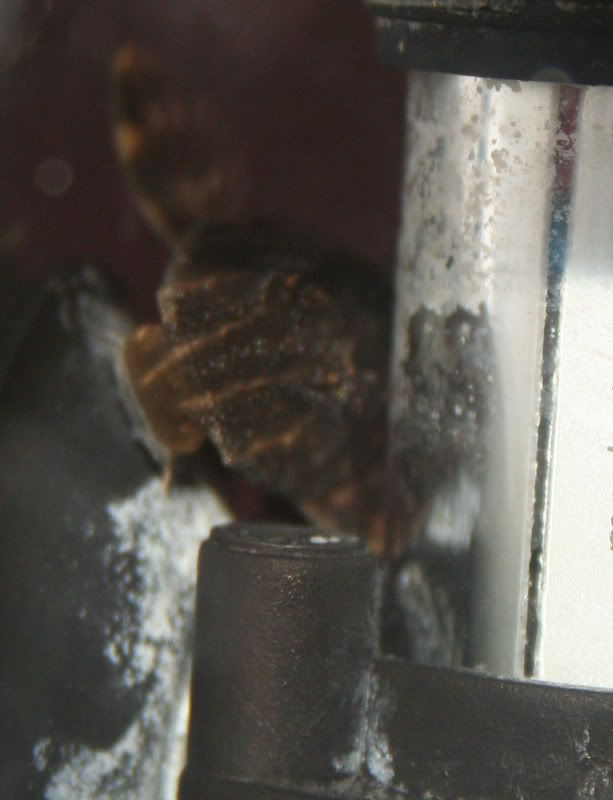
He is eating that white stuff that I can't get to come off.
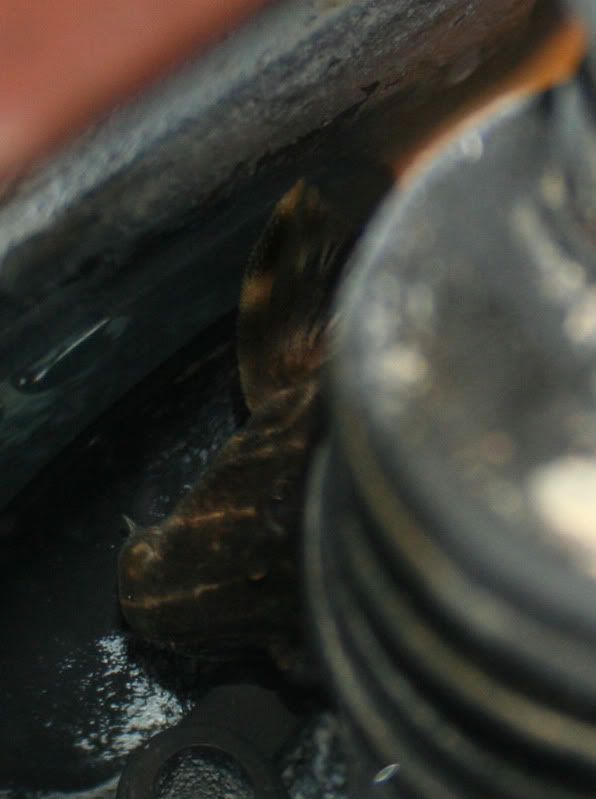
Image taken from above tank... he's only about a half inch from the top.
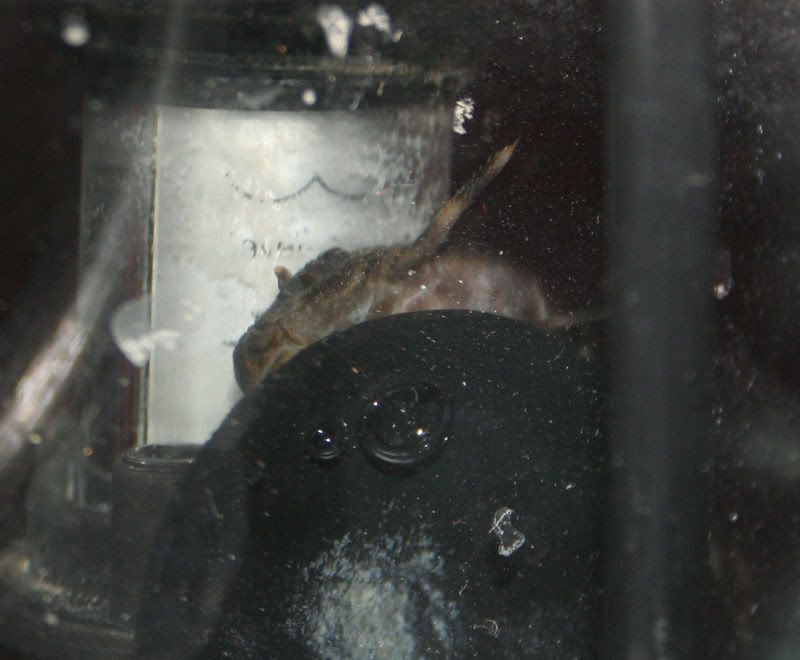
Picture taken of a mirror trying to get a pic from behind the tank so I could see his stomach.
-Greg Kirby
P.S. My Ammonia/Ammonium level is rather high due to the fact that my tank cycled again, but my Nitrate level is less than 25ppm. Could the Ammonia level be the reason he is acting rather odd and not hiding during the day (due to stress)?
- apistomaster
- Posts: 4735
- Joined: 10 Jun 2006, 14:26
- I've donated: $90.00!
- My articles: 1
- My cats species list: 12 (i:0, k:0)
- My Wishlist: 1
- Location 1: Clarkston, WA, USA
- Location 2: Clarkston, WA, USA
- Interests: Aquaculture and flyfishing
Probably little else matters until you get this tank stabilized. The fish in the photos is not starving so there is no great urgency to make it eat. Sounds like it is removing the algae/biofilm attached to the roughened surface of the mineral deposits so it is getting by Increase water changes to dilute the ammonia. Try adding preconditioned media from another filter, add bacteria starters, Amquel, basically pull out the stops. You will really rarely see them eating in daylight and/or if they sense your presence. Try parboiled zuchinni. Remove all uneaten food and replace with fresh once a night anything to minimize decay. P. maccus are durable. Yours will get through this.
Avid Trout fly fisherman. ·´¯`·...¸><)))º>
I have started a little experiment....
Right when I purchased my Clown Plecos I also added a sizable piece of Malaysian driftwood to my tank. My hypothesis for this experiment is that the drift wood has been decomposing in the tank releasing a very large amount of ammonia (tank water is currently at 4ppm Ammonia/Ammonium). To do this experiment I have two test tubes filled each with 5mL of water (tap water with known concentration of ammonia to be less than or equal to .25ppm). In one of these test tubes I have placed a piece of the wood. In the other there is nothing except the water. I have capped both tubes and will let them sit for an hour. At which point I will use my Ammonia/Ammonium test to see if the one with the driftwood has a higher concentration of this toxic substance.
-Greg Kirby
Edit:
I removed the wood from the tank. I will test this water later tonight to see if there is any positive change that the lack of wood has made.
Edit #2:
My other Clown was under the driftwood as I suspected and looked fine as he swam away angry because I got rid of his home...
because I got rid of his home...
Right when I purchased my Clown Plecos I also added a sizable piece of Malaysian driftwood to my tank. My hypothesis for this experiment is that the drift wood has been decomposing in the tank releasing a very large amount of ammonia (tank water is currently at 4ppm Ammonia/Ammonium). To do this experiment I have two test tubes filled each with 5mL of water (tap water with known concentration of ammonia to be less than or equal to .25ppm). In one of these test tubes I have placed a piece of the wood. In the other there is nothing except the water. I have capped both tubes and will let them sit for an hour. At which point I will use my Ammonia/Ammonium test to see if the one with the driftwood has a higher concentration of this toxic substance.
-Greg Kirby
Edit:
I removed the wood from the tank. I will test this water later tonight to see if there is any positive change that the lack of wood has made.
Edit #2:
My other Clown was under the driftwood as I suspected and looked fine as he swam away angry
gakirby wrote:I have started a little experiment....
Right when I purchased my Clown pl*cos I also added a sizable piece of Malaysian driftwood to my tank. My hypothesis for this experiment is that the drift wood has been decomposing in the tank releasing a very large amount of ammonia (tank water is currently at 4ppm Ammonia/Ammonium). To do this experiment I have two test tubes filled each with 5mL of water (tap water with known concentration of ammonia to be less than or equal to .25ppm). In one of these test tubes I have placed a piece of the wood. In the other there is nothing except the water. I have capped both tubes and will let them sit for an hour. At which point I will use my Ammonia/Ammonium test to see if the one with the driftwood has a higher concentration of this toxic substance.
The results are in and my hypothesis was right
Here is my setup...
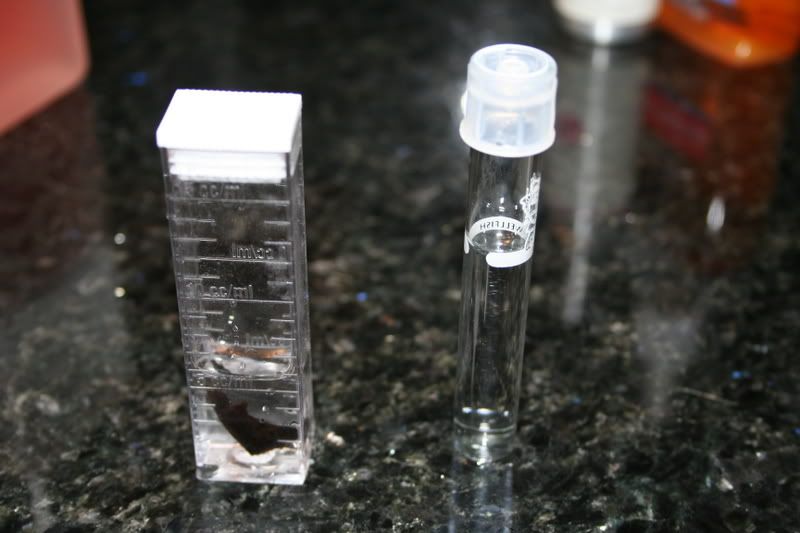
The results...
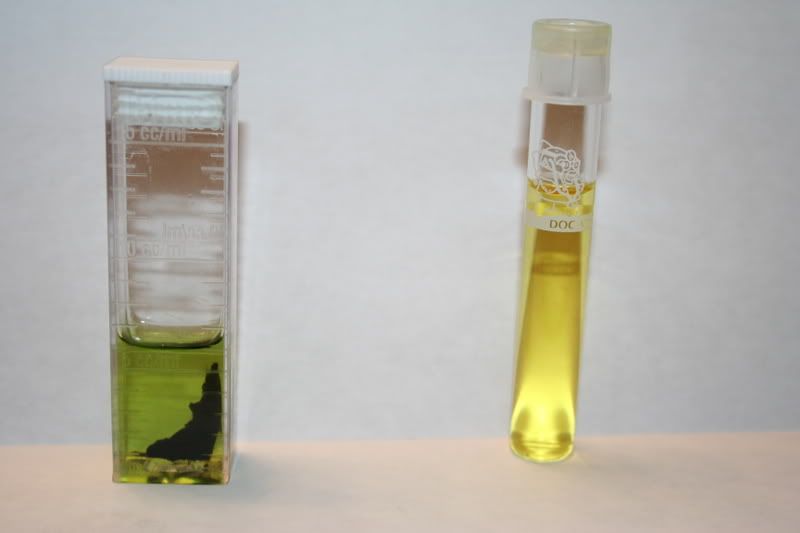
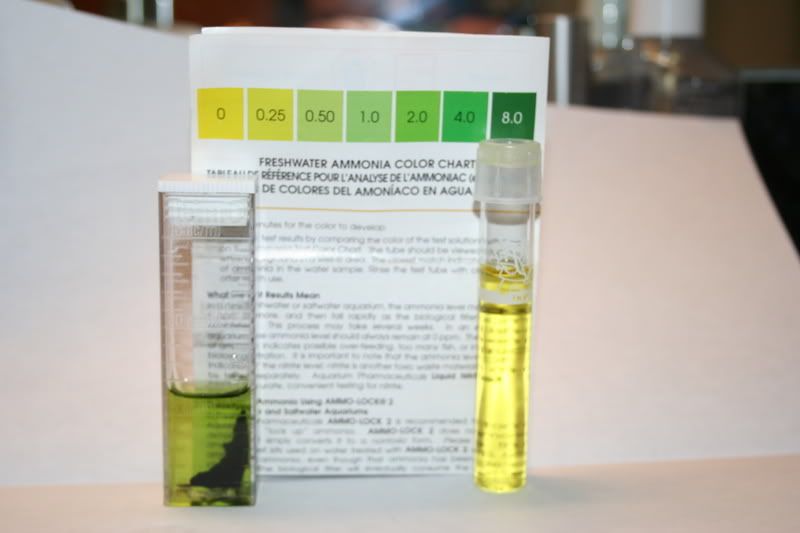
Well I geuss that mystery is solved... now I just have to get my levels back down, buy some better wood, and get my plecos chewing on some zucchini...
-Greg Kirby
P.S. Although "Zilla-Rules Medium Malaysia Driftwood (purchased in Reptile section of Petco, Link Here)" is safe for aquariums as they say on the tag (because they don't add any chemicals to preserve it), it will eventually kill your fish anyway (edit: due to the Ammonia it releases into your tank as it decomposes). Oh how I love irony...
P.P.S. Does anyone have a preference of what type of wood to use, Malaysian, bogwood, etc. ???
Last edited by gakirby on 31 Dec 2006, 21:27, edited 1 time in total.
- apistomaster
- Posts: 4735
- Joined: 10 Jun 2006, 14:26
- I've donated: $90.00!
- My articles: 1
- My cats species list: 12 (i:0, k:0)
- My Wishlist: 1
- Location 1: Clarkston, WA, USA
- Location 2: Clarkston, WA, USA
- Interests: Aquaculture and flyfishing
Hi Greg,
I have no experience with Zilla Malaysian Driftwood but I don't understand why you say it will kill your fish anyway. I have only bought generic Malaysian Driftwood.
It always releases a ton of tannins if used "as is".
Unless the wood is contaminated with a toxin prolonged soaking or a few repeated boiling has always rendered it useable for me. Sometimes with some Chlorox if I'm in a rush. Tannin releases still continue at a lesser degree. Usually that is not objectionable or problamatic in a SA fish environment. I use a lot of this stuff and natural locally collected driftwood.
Your clowns will need the wood in their diet and as you noted they enjoy the secure hiding places it provides.
I'm sure that you have this problem under control but it sounded like you are very concerned about this driftwood's safety in your aquariums.
I have had several of the black and white "L333" adopt the more traditional brown and tan pattern when kept with a lot of driftwood in their tanks. A positive effect IMO since that is what I think L333's should look like.
I'm just thinking out loud. Wish you success.
I have no experience with Zilla Malaysian Driftwood but I don't understand why you say it will kill your fish anyway. I have only bought generic Malaysian Driftwood.
It always releases a ton of tannins if used "as is".
Unless the wood is contaminated with a toxin prolonged soaking or a few repeated boiling has always rendered it useable for me. Sometimes with some Chlorox if I'm in a rush. Tannin releases still continue at a lesser degree. Usually that is not objectionable or problamatic in a SA fish environment. I use a lot of this stuff and natural locally collected driftwood.
Your clowns will need the wood in their diet and as you noted they enjoy the secure hiding places it provides.
I'm sure that you have this problem under control but it sounded like you are very concerned about this driftwood's safety in your aquariums.
I have had several of the black and white "L333" adopt the more traditional brown and tan pattern when kept with a lot of driftwood in their tanks. A positive effect IMO since that is what I think L333's should look like.
I'm just thinking out loud. Wish you success.
Avid Trout fly fisherman. ·´¯`·...¸><)))º>
I understand your confusion. The reason I made the statement about killing your fish anyway is that it is not properly cured by the company and will continue to decompose in your tank. To prep mine I boiled it for a half hour, this was after a week of soaking... unless you have any other suggestions this wood seems to be rather useless in an aquarium environment and seems to be better suited for a terrarium for keeping your reptile friends.
I am well aware of the need of wood for my Clowns' diets that being the reason that in the post script I said that I needed to find better wood for them at a Fish Store instead of a Nationwide Generic Pet Store.
-Greg Kirby
I am well aware of the need of wood for my Clowns' diets that being the reason that in the post script I said that I needed to find better wood for them at a Fish Store instead of a Nationwide Generic Pet Store.
-Greg Kirby
Just as another note about this driftwood while I am still thinking about it, when I took it out it was very soft (despite the hardness of Malaysian wood) and appears to be in the early stages of rotting despite only being in the tank for >3 days.
Once again thank you for your help and interest in my situation.
-Greg Kirby
Once again thank you for your help and interest in my situation.
-Greg Kirby
- apistomaster
- Posts: 4735
- Joined: 10 Jun 2006, 14:26
- I've donated: $90.00!
- My articles: 1
- My cats species list: 12 (i:0, k:0)
- My Wishlist: 1
- Location 1: Clarkston, WA, USA
- Location 2: Clarkston, WA, USA
- Interests: Aquaculture and flyfishing
Now I understand. I have only bought Malaysian driftwood that has been selected for aquarium use and I find what I have bought is safe and durable. However, some of the driftwood I collect is from the trees of the PNW. Plecos can reduce some of those by volume at a rate of 20% a year and produce a lot of "saw dung" in the process. It is really amazing how fast some species go through the soft wood.
Avid Trout fly fisherman. ·´¯`·...¸><)))º>
I just did a 20-25% water change to help with the ammonia problem. The P. Maccus is doing fine, swimming strongly and behaving well despite the circumstances (I think he is enjoying that the lights have not been used all day).
The LDA68 however is still very lethargic. In order to do the water change I had to move him from heater suction cup as there would be no water in that area during the change. After a small nudge with the net he went on to the glass and slid down, as if he couldn't suction onto it properly. He has now moved only about an inch or so. Hopefully all his activities will commence again as the water quality increases.
Once again thanks for all the interest and insight you have given my situation and this thread.
-Greg Kirby
The LDA68 however is still very lethargic. In order to do the water change I had to move him from heater suction cup as there would be no water in that area during the change. After a small nudge with the net he went on to the glass and slid down, as if he couldn't suction onto it properly. He has now moved only about an inch or so. Hopefully all his activities will commence again as the water quality increases.
Once again thanks for all the interest and insight you have given my situation and this thread.
-Greg Kirby
Just two things that I have been thinking of...
1. Is it possible that changing the water too much is hindering the development of the biological filter?
2. The fact that my LDA68 is about an inch from the surface of the tank (again), could that mean I should but an airstone in the tank to help him breath easier?
I'm going to test the water again tomorrow and do another water change, probably closer to 40-50% unless you guys think this would an unproductive towards reaching a stable water quality.
-Greg Kirby
1. Is it possible that changing the water too much is hindering the development of the biological filter?
2. The fact that my LDA68 is about an inch from the surface of the tank (again), could that mean I should but an airstone in the tank to help him breath easier?
I'm going to test the water again tomorrow and do another water change, probably closer to 40-50% unless you guys think this would an unproductive towards reaching a stable water quality.
-Greg Kirby
- apistomaster
- Posts: 4735
- Joined: 10 Jun 2006, 14:26
- I've donated: $90.00!
- My articles: 1
- My cats species list: 12 (i:0, k:0)
- My Wishlist: 1
- Location 1: Clarkston, WA, USA
- Location 2: Clarkston, WA, USA
- Interests: Aquaculture and flyfishing
1. Yes, it can but a balance needs to be struck. Fresh water can refresh the supply of some micronutrients that the bacteria will use. Still it is good to dilute the cloudy water while the the beneficial bateria colonies begin growing well on the biofilter substrates. The artificial slime coat in water conditioners facilitate that process to begin with. A flocculating agent may also help with this. Something like SeaChem Clarity may be useful. It all will level out in time even without taking any actions and these products may help speed up the process a little. Also adding a cycling bacteria preparation in conjunction with the above actions may help establish dominate colonies of beneficial bacteria. If you have access to a diatom filter the water can be polished crystal clear in an hour or two. These filters are a hassle and expensive and you only need them on occassions like this for making an immediate improvement. It sounds like the stocking level began too soon, too high and feeding aggravated the situation. All my suggestions are aimed towards making the best of a bad situation and are not guarantees that things will level out without some loss of aquatic life.
We all have done this sort of thing before. Probabably more than once. Chock this incident up to experience and do what you can. These are just recommendations and things that have been helpful for me. Other members may have some better ideas.
I wish you good luck and encourage you to not let this let you become disillusioned about keeping tropical fish if you experience any setbacks.
2. Additional aeration may help the pleco. It may be diseased and it's behavior may be symptoms. Moving it may stress it enough to kill it. It may be dying no matter what you do for it. Moving it to a separate hospital tank with an already working biological filter may relieve it's distress and let you determine what is wrong and whether there is a disease that you can treat successfully. I have a feeling this fish isn't going to make it no matter what you do. I just have that feeling but can't really tell you why except that is comes from my personal experience.
We all have done this sort of thing before. Probabably more than once. Chock this incident up to experience and do what you can. These are just recommendations and things that have been helpful for me. Other members may have some better ideas.
I wish you good luck and encourage you to not let this let you become disillusioned about keeping tropical fish if you experience any setbacks.
2. Additional aeration may help the pleco. It may be diseased and it's behavior may be symptoms. Moving it may stress it enough to kill it. It may be dying no matter what you do for it. Moving it to a separate hospital tank with an already working biological filter may relieve it's distress and let you determine what is wrong and whether there is a disease that you can treat successfully. I have a feeling this fish isn't going to make it no matter what you do. I just have that feeling but can't really tell you why except that is comes from my personal experience.
Avid Trout fly fisherman. ·´¯`·...¸><)))º>
-
Bas Pels
- Posts: 2917
- Joined: 21 Dec 2006, 20:35
- My images: 1
- My cats species list: 28 (i:0, k:0)
- Spotted: 8
- Location 1: the Netherlands
- Location 2: Nijmegen the Netherlands
- Interests: Central American and Uruguayan fishes
Regarding the issue - the dood does increase the ammonia leves considerably, I wonder whether this observation is generally true for all kinds of wood. In fact I think it does not.
Wood for keeping repitels will generally bve dryk and perhaps previously used with reptiles. Repiles do not excreate ammonia (as fish do) or ureum (as humans, and other mammals do) but they excrete ureumacid, which does not dissolve in water.
due to this lack of disolving capability, it will remain on the wood fvor a long time, but it does decompose into ammonia eventually (just as ureum does)
Only because of this - it does not dissolve, but does produce ammonia, wood contaminated with ureumacid is unsuited for aquarium use.
I have in all my tanks (25 of them) wood, most of it is not cured in peet, but plainly wood which will sink after a (sometimes very long)while.
I do this for my Loricarid catfish (Pterogoblichthys, Ancistrus, Hypostomus) which need wood as a lignin source.
I'm afraid something which used to be wood coming from a factory will not aatisfy this need. In gfact I started keeping these catfish in order to keep the (not really suited for aquarium) wood fresh
Wood for keeping repitels will generally bve dryk and perhaps previously used with reptiles. Repiles do not excreate ammonia (as fish do) or ureum (as humans, and other mammals do) but they excrete ureumacid, which does not dissolve in water.
due to this lack of disolving capability, it will remain on the wood fvor a long time, but it does decompose into ammonia eventually (just as ureum does)
Only because of this - it does not dissolve, but does produce ammonia, wood contaminated with ureumacid is unsuited for aquarium use.
I have in all my tanks (25 of them) wood, most of it is not cured in peet, but plainly wood which will sink after a (sometimes very long)while.
I do this for my Loricarid catfish (Pterogoblichthys, Ancistrus, Hypostomus) which need wood as a lignin source.
I'm afraid something which used to be wood coming from a factory will not aatisfy this need. In gfact I started keeping these catfish in order to keep the (not really suited for aquarium) wood fresh
- apistomaster
- Posts: 4735
- Joined: 10 Jun 2006, 14:26
- I've donated: $90.00!
- My articles: 1
- My cats species list: 12 (i:0, k:0)
- My Wishlist: 1
- Location 1: Clarkston, WA, USA
- Location 2: Clarkston, WA, USA
- Interests: Aquaculture and flyfishing
It seems to me that only using wood with proven aquarium saftey is the best choice. Wood never used with reptiles. It could be from a fish shop or collected from a local stream. You just have to know that it has been proven safe.
I collect wood from sand bars exposed in the low water season and it s dug out from the sand where it is already waterlogged. I choose the densest pieces, often root burls because of the interesting shapes I find it in. It has to have been buried for years to be as waterlogged as it is because it is so dense. I have been doing this for all 40 plus years I have been an aquarist and I am fortunate that I have access to many clean streams and rivers. They are also my favorite trout fly fishing streams. I also like the Malayasian wood sold for aquarium use. I have been fortunate because I have never had any of my collected wood cause any fish keeping problems.
I collect wood from sand bars exposed in the low water season and it s dug out from the sand where it is already waterlogged. I choose the densest pieces, often root burls because of the interesting shapes I find it in. It has to have been buried for years to be as waterlogged as it is because it is so dense. I have been doing this for all 40 plus years I have been an aquarist and I am fortunate that I have access to many clean streams and rivers. They are also my favorite trout fly fishing streams. I also like the Malayasian wood sold for aquarium use. I have been fortunate because I have never had any of my collected wood cause any fish keeping problems.
Avid Trout fly fisherman. ·´¯`·...¸><)))º>
- apistomaster
- Posts: 4735
- Joined: 10 Jun 2006, 14:26
- I've donated: $90.00!
- My articles: 1
- My cats species list: 12 (i:0, k:0)
- My Wishlist: 1
- Location 1: Clarkston, WA, USA
- Location 2: Clarkston, WA, USA
- Interests: Aquaculture and flyfishing
Hi Bas,
It is true that I am fortunate to live in a part of the Pacific Northwest USA that has many of the finest of what are officially classified as "Wild and Scenic Rivers" in this large country. I am surrounded by these pure waters still full of the native wild trouts, the Cutthroat Trout and both the Resident and Searun Rainbow Trout which average about 7 Kilos and are called Steelhead Trout. I grew up here and I am as crazy for fly fishing as I am for tropical fish. My local rivers drain from the West slopes of the Rocky Mountains to the Pacific. We just have a bad habit of damming rivers here but the wild and scenic rivers are hands off to dam building by Federal Law.
It is true that I am fortunate to live in a part of the Pacific Northwest USA that has many of the finest of what are officially classified as "Wild and Scenic Rivers" in this large country. I am surrounded by these pure waters still full of the native wild trouts, the Cutthroat Trout and both the Resident and Searun Rainbow Trout which average about 7 Kilos and are called Steelhead Trout. I grew up here and I am as crazy for fly fishing as I am for tropical fish. My local rivers drain from the West slopes of the Rocky Mountains to the Pacific. We just have a bad habit of damming rivers here but the wild and scenic rivers are hands off to dam building by Federal Law.
Avid Trout fly fisherman. ·´¯`·...¸><)))º>
I have spent the last few hours combing through the forums for anything that contained the word "cycling." Needless to say I found tons of information shared by many people. I am currently using Stress-Zyme but it appears that many people have found this to be a pretty unsuccessful approach. Many of these people have recommended Bio-Spira to do fishless cycling. As this approach uses beneficial bacteria instead of massive amounts of ammonia I was wondering if it was safe to use this product in an occupied aquarium.
I also read that increased tank movement and oxygen increase the rate of NH3 decomposition so I will get an airstone hopefully tomorrow (New Years is kind of a pain when you need to buy something).
-Greg Kirby
I also read that increased tank movement and oxygen increase the rate of NH3 decomposition so I will get an airstone hopefully tomorrow (New Years is kind of a pain when you need to buy something).
-Greg Kirby
